Salar de Atacama Lithium and Potassium Productive Process
Abstract
1. Theoretical Lithium Background
1.1. Lithium Deposits—Introduction
1.2. Lithium Deposits in Continental Brines
2. Lithium Production Process in Continental Brines
2.1. Fractional Precipitation
2.2. Solubility
2.3. Common Ion Effect
2.4. Operational Parameters
- Mg/Li ratio: Determines the amount of magnesium that must be removed by fractional crystallization or selective precipitation. Currently, mainly brines with low Mg/Li ratios are used for lithium production [10], while a Mg/Li ratio greater than 10 has not made production on an industrial scale profitable. Magnesium is particularly difficult to separate from lithium, in part, because they are elements with very similar properties. There is a diagonal relationship between the two, this mainly because the atomic and ionic sizes are similar [11]. Li+ has a radius of 0.60 °A (0.06 nm) and Mg2+ a radius of 0.65 °A (0.065 nm). For its part, Na+ has a radius of 0.95 °A (0.095 nm), which makes it almost incompatible to replace lithium or magnesium in a crystalline structure (See Figure 3). This is evident when lithium carbonate presents properties similar to magnesium carbonate and not to the homologues of its group such as potassium carbonate or sodium carbonate [12]. In many other respects, lithium resembles magnesium and other alkaline earth elements and differs from the properties of Group 1 alkali metals. Diagonal relationships are important to predict the chemical behavior of a given element, as well as its compounds [13].
- SO4/Li Ratio: This parameter determines if the deposit is lithium chloride (low SO4/Li) or lithium sulfate (high SO4/Li). At a high ratio, lithium sulfate salts typically begin to precipitate from lithium concentrations between 0.5% and 1% [14]. The determination of the type of deposit can alternatively be identified through the SO4/Mg ratio (see Table 2).
- Ca/Li ratio: Determines the amount of calcium that must be removed by fractional crystallization or selective precipitation.
- SO4/K Ratio: Indicates a Potassium Sulfate deposit (high SO4/K) or Potassium Chloride deposit (low SO4/K).
- SO4/Ca ratio: When calcium concentrations are high, sulfate concentrations are low, and the same thing happens inversely. This parameter also defines yield losses due to lithium sulfate precipitation when sulfate contents are in excess, that is, with a SO4/Ca ratio greater than 2.4, which represents the stoichiometric ratio for calcium sulfate precipitation. Values above 2.4 can cause lithium sulfate precipitation in more concentrated systems. For this reason, it is said that calcium is a regulator of sulfate content. In this sense, this is one of the most relevant parameters for the definition of fractional precipitation processes [4].
2.5. Conversion to Lithium Carbonate and Lithium Hydroxide
3. The Salar de Atacama
3.1. Marginal Zone
3.2. The Nucleus
3.3. The Origin of Lithium in the Salar de Atacama
4. Salar de Atacama Productive Process
4.1. Solar Evaporation Ponds
4.2. Brine Extraction
4.3. Constructions of the Ponds
4.4. Baffles
4.5. Pond Process
4.6. Lithium Production Systems (MOPI)
4.7. Halite Systems
4.8. Sylvinite Systems
4.9. Potassium Carnallite Systems
4.10. Bischofite Systems
4.11. Lithium Carnallites
4.12. Concentrated Brine
4.13. Harvest and Impregnation
4.14. Salar del Carmen Chemical Plant
4.15. Boron Removal
4.16. Purification
4.16.1. First Phase of Purification
4.16.2. Second Phase of Purification
4.17. Carbonation
4.18. Dried and Compacted
4.19. Packaging Area
4.20. Lithium Hydroxide Plant
- Reaction;
- Clarification and filtration;
- Decantation and centrifugation;
- Evaporation and Crystallization;
- Centrifugation;
- Drying and cooling;
- Packaging and storage.
4.21. Reaction
4.22. Clarification and Filtration
4.23. Decantation and Centrifugation
4.24. Evaporation and Crystallization
4.25. Centrifugation
4.26. Drying and Cooling
4.27. Packaging and Storage
5. Conclusions
Author Contributions
Funding
Data Availability Statement
Conflicts of Interest
References
- Murodjon, S.; Yu, X.; Li, M.; Duo, J.; Deng, T. Lithium Recovery from Brines Including Seawater, Salt Lake Brine, Underground Water and Geothermal Water. In Thermodynamics and Energy Engineering; IntechOpen: London, UK, 2020. [Google Scholar]
- Retamal, J.I.; Robles, P.A.; Quezada, G.R.; Jeldres, R.I. Molecular Design and Spodumene Flotation—A Review. Int. J. Mol. Sci. 2024, 25, 3227. [Google Scholar] [CrossRef] [PubMed]
- Morales, Y.; Herrera, N.; Pérez, K. Lithium Carbonate Sedimentation Using Flocculants with Different Ionic Bases. Hem. Ind. 2021, 75, 205–212. [Google Scholar] [CrossRef]
- Toro Villarroel, N.R.; Torres Albornoz, D.A. La Fuerza Del Litio; Universidad Arturo Prat: Iquique, Chile, 2023; ISBN 9789564164717. [Google Scholar]
- Garrett, D.E. Handbook of Lithium and Natural Calcium Chloride; Elsevier: Amsterdam, The Netherlands, 2004; ISBN 9780122761522. [Google Scholar]
- Meng, F.; McNeice, J.; Zadeh, S.S.; Ghahreman, A. Review of Lithium Production and Recovery from Minerals, Brines, and Lithium-Ion Batteries. Miner. Process. Extr. Metall. Rev. 2021, 42, 123–141. [Google Scholar] [CrossRef]
- Talens Peiró, L.; Villalba Méndez, G.; Ayres, R.U. Lithium: Sources, Production, Uses, and Recovery Outlook. JOM 2013, 65, 986–996. [Google Scholar] [CrossRef]
- Haynes, W.M. (Ed.) CRC Handbook of Chemistry and Physics, 95th ed.; CRC Press: Boca Raton, FL, USA, 2014; ISBN 9780429170195. [Google Scholar]
- Seidell, A.; Linke, W.F. Solubilities of Inorganic and Organic Componds. A Compilation of Quantitative Solubility Data from the Periodical Literature. J. Am. Med. Assoc. 1928, 91, 1131. [Google Scholar] [CrossRef][Green Version]
- Virolainen, S.; Fallah Fini, M.; Miettinen, V.; Laitinen, A.; Haapalainen, M.; Sainio, T. Removal of Calcium and Magnesium from Lithium Brine Concentrate via Continuous Counter-Current Solvent Extraction. Hydrometallurgy 2016, 162, 9–15. [Google Scholar] [CrossRef]
- Housecroft, C.; Sharp, A.G. Química Inorgánica; Oxford University Press: Oxford, UK, 2006; ISBN 978-8420548470. [Google Scholar]
- Rochow, E.G. Química Inorgánica; Oxford University Press: Oxford, UK, 2008; ISBN 978-8429174847. [Google Scholar]
- Gray, H.B. Chemical Bonds: An Introduction to Atomic and Molecular Structure; University Science Books: Sausalito, CA, USA, 1994; ISBN 978-0935702354. [Google Scholar]
- Ehren, P. Process for Producing Lithium Carbonate from Concentrated Lithium Brine. U.S. Patent 2014/0334997 A1, 13 November 2014. [Google Scholar]
- Boryta, D.A.; Kullberg, T.F.; Thurston, A.M. Revovery of Lithium Componds from Brines. U.S. Patent 6,207,126 B1, 27 March 2001. [Google Scholar]
- Perez, W.; Bravo, H.A.C.B.; Suarez, C.; Bravo, M. Method for the Production of Battery Grade Lithium Carbonate from Natural and Industrial Brines. U.S. Patent 8,691,169 B2, 8 April 2014. [Google Scholar]
- Hamzaoui, A.H.; M’nif, A.; Hammi, H.; Rokbani, R. Contribution to the Lithium Recovery from Brine. Desalination 2003, 158, 221–224. [Google Scholar] [CrossRef]
- Intaranont, N.; Garcia-Araez, N.; Hector, A.L.; Milton, J.A.; Owen, J.R. Selective Lithium Extraction from Brines by Chemical Reaction with Battery Materials. J. Mater. Chem. A 2014, 2, 6374–6377. [Google Scholar] [CrossRef]
- Godfrey, L.; Álvarez-Amado, F. Volcanic and Saline Lithium Inputs to the Salar de Atacama. Minerals 2020, 10, 201. [Google Scholar] [CrossRef]
- Fukuda, H. Lithium Extraction from Brine with Ion Exchange Resin and Ferric Phosphate. Ph.D. Thesis, University of British Columbia, Vancouver, BC, Canada, 2019. [Google Scholar]
- García-Gil, A.; Vázquez-Suñé, E.; Ayora, C.; Tore, C.; Henríquez, Á.; Yáñez, J. Impacts of the Transient Skin Effect during Brine Extraction Operations in a Crystalline Halite Aquifer. J. Hydrol. 2019, 577, 123912. [Google Scholar] [CrossRef]
- Reutter, K.-J.; Charrier, R.; Götze, H.-J.; Schurr, B.; Wigger, P.; Scheuber, E.; Giese, P.; Reuther, C.-D.; Schmidt, S.; Rietbrock, A.; et al. The Salar de Atacama Basin: A Subsiding Block within the Western Edge of the Altiplano-Puna Plateau. In Frontiers in Earth Sciences; Springer: Berlin/Heidelberg, Germany, 2006; pp. 303–325. [Google Scholar]
- Muñoz-Pardo, J.F.; Ortiz-Astete, C.A.; Mardones-Pérez, L.; de Vidts-Sabelle, P. Funcionamiento Hidrogeológico Del Acuífero Del Núcleo Del Salar de Atacama, Chile. Ing. Hidraul. Mex. 2004, 19, 69–81. [Google Scholar]
- Lovera, J.A.; Graber, T.A.; Galleguillos, H.R. Correlation of Solubilities for the NaCl + LiCl + H2O System with the Pitzer Model at 15, 25, 50, and 100 °C. Calphad 2009, 33, 388–392. [Google Scholar] [CrossRef]
- Munk, L.A.; Boutt, D.F.; Hynek, S.; Moran, B. Hydrogeochemical Fluxes and Processes Contributing to the Formation of Lithium-Enriched Brines in a Hyper-Arid Continental Basin. Chem. Geol. 2018, 493, 37–57. [Google Scholar] [CrossRef]
- Marazuela, M.A.; Vázquez-Suñé, E.; Custodio, E.; Palma, T.; García-Gil, A.; Ayora, C. 3D Mapping, Hydrodynamics and Modelling of the Freshwater-Brine Mixing Zone in Salt Flats Similar to the Salar de Atacama (Chile). J. Hydrol. 2018, 561, 223–235. [Google Scholar] [CrossRef]
- Yañez, O. Gestión del Conocimiento en Sqm Salar. Master’s Thesis, Universidad de Chile, Santiago, Chile, 2006. [Google Scholar]
- Lagos, G. El Desarrollo Del Litio En Chile: 1984–2012; Centro de Minerí: Santaigo, Chile, 2012; Available online: http://www.gustavolagos.cl/uploads/1/2/4/2/12428079/el_desarrollo_del_litio_en_chile_g._lagos_21-8-12_a.pdf (accessed on 15 September 2024).
- Jordan, T.E.; Muñoz, N.; Hein, M.; Lowenstein, T.; Godfrey, L.; Yu, J. Active Faulting and Folding without Topographic Expression in an Evaporite Basin, Chile. Geol. Soc. Am. Bull. 2002, 114, 1406–1421. [Google Scholar] [CrossRef]
- Marazuela, M.A.; Ayora, C.; Vázquez-Suñé, E.; Olivella, S.; García-Gil, A. Hydrogeological Constraints for the Genesis of the Extreme Lithium Enrichment in the Salar de Atacama (NE Chile): A Thermohaline Flow Modelling Approach. Sci. Total Environ. 2020, 739, 139959. [Google Scholar] [CrossRef]
- Amado, F.A.; Rosales, M.; Cofré, E.; Godfrey, L. Sources of Lithium in Brine Deposits of the Atacama Desert, Northern Chile. In Proceedings of the Goldschmidt Conference, Barcelona, Spain, 18–23 August 2019; p. 73. [Google Scholar]
- Munk, L.A.; Hynek, S.A.; Bradley, D.C.; Boutt, D.; Labay, K.; Jochens, H. Lithium Brines: A Global Perspective. In Rare Earth and Critical Elements in Ore Deposits; Society of Economic Geologists: Littleton, CO, USA, 2016; pp. 1–9. [Google Scholar]
- Heidari, N.; Momeni, P. Selective Adsorption of Lithium Ions from Urmia Lake onto Aluminum Hydroxide. Environ. Earth Sci. 2017, 76, 551. [Google Scholar] [CrossRef]
- Collazo, S. Evaporación Mecánica de Salmueras de Litio. Diploma Thesis, Universidad Andrés Bello, Santiago, Chile, 2017. [Google Scholar]
- Igsa Consultores. Cambios y Mejoras de La Operación Minera En El Salar de Atacama; Igsa Consultores: Santiago, Chile, 2005. [Google Scholar]
- da Silva, R.G.; Seckler, M.; Rocha, S.D.F.; Saturnino, D.; de Oliveira, É.D. Thermodynamic Modeling of Phases Equilibrium in Aqueous Systems to Recover Potassium Chloride from Natural Brines. J. Mater. Res. Technol. 2017, 6, 57–64. [Google Scholar] [CrossRef]
- An, J.W.; Kang, D.J.; Tran, K.T.; Kim, M.J.; Lim, T.; Tran, T. Recovery of Lithium from Uyuni Salar Brine. Hydrometallurgy 2012, 117–118, 64–70. [Google Scholar] [CrossRef]
- Yaksic, A.; Tilton, J.E. Using the Cumulative Availability Curve to Assess the Threat of Mineral Depletion: The Case of Lithium. Resour. Policy 2009, 34, 185–194. [Google Scholar] [CrossRef]
- Soto-Bubert, A.; de las Pozas, C.; Navarro, G.; Acevedo, R. Drenaje de Salmueras En Sales de Halita; Universidad Mayor: Santiago, Chile, 2019. [Google Scholar]
- Fan, X.; Yu, X.; Guo, Y.; Deng, T. Recovery of Boron from Underground Brine by Continuous Centrifugal Extraction with 2-Ethyl-1,3-Hexanediol (EHD) and Its Mechanism. J. Chem. 2018, 2018, 7530837. [Google Scholar] [CrossRef]
- Wilkomirsky, I. Process for Removing Boron from Brines. U.S. Patent 5,939,03, 7 August 1999. [Google Scholar]
- Martin, S.L.D.; Díaz, N.G.; Frades, T.M. Mixing and Settling Method and Device in Solvent Extraction Processes to Recover High-Purity Products. U.S. Patent 2005/021 A1, 6 October 2005. [Google Scholar]
- Cabrera, V.; Velásquez, C. Factibilidad Tecnico Economica de La Producción de Hidróxido de Litio a Pequeña Escala a Partir de Salmueras. In Proceedings of the 17th LACCEI International Multi-Conference for Engineering, Education, and Technology: “Industry, Innovation, and Infrastructure for Sustainable Cities and Communities”, Montego Bay, Jamaica, 24–26 July 2019; Latin American and Caribbean Consortium of Engineering Institutions: Boca Raton, FL, USA, 2019. [Google Scholar]
- Grágeda, M.; González, A.; Alavia, W.; Ushak, S. Development and Optimization of a Modified Process for Producing the Battery Grade LiOH: Optimization of Energy and Water Consumption. Energy 2015, 89, 667–677. [Google Scholar] [CrossRef]
- Taboada, M.E.; Graber, T.A.; Cisternas, L.A.; Cheng, Y.S.; Ng, K.M. Process Design for Drowning-Out Crystallization of Lithium Hydroxide Monohydrate. Chem. Eng. Res. Des. 2007, 85, 1325–1330. [Google Scholar] [CrossRef]
- Graber, T.A.; Taboada, M.E.; Cortés, L.; Piceros, E.; Meruane, G.; Aguilar, P. Reactive Crystallization Process of Li2CO3 from LiCl and Na2CO3 Mechanism and Modeling. Ind. Eng. Chem. Res. 2024, 63, 10299–10308. [Google Scholar] [CrossRef]
- Graber, T.A.; Morales, J.W.; Robles, P.A.; Galleguillos, H.R.; Taboada, M.E. Behavior of LiOH·H2O Crystals Obtained by Evaporation and by Drowning Out. Cryst. Res. Technol. 2008, 43, 616–625. [Google Scholar] [CrossRef]
- Kim, K. Recovery of Lithium Hydroxide from Spent Lithium Carbonate Using Crystallizations. Sep. Sci. Technol. 2008, 43, 420–430. [Google Scholar] [CrossRef]

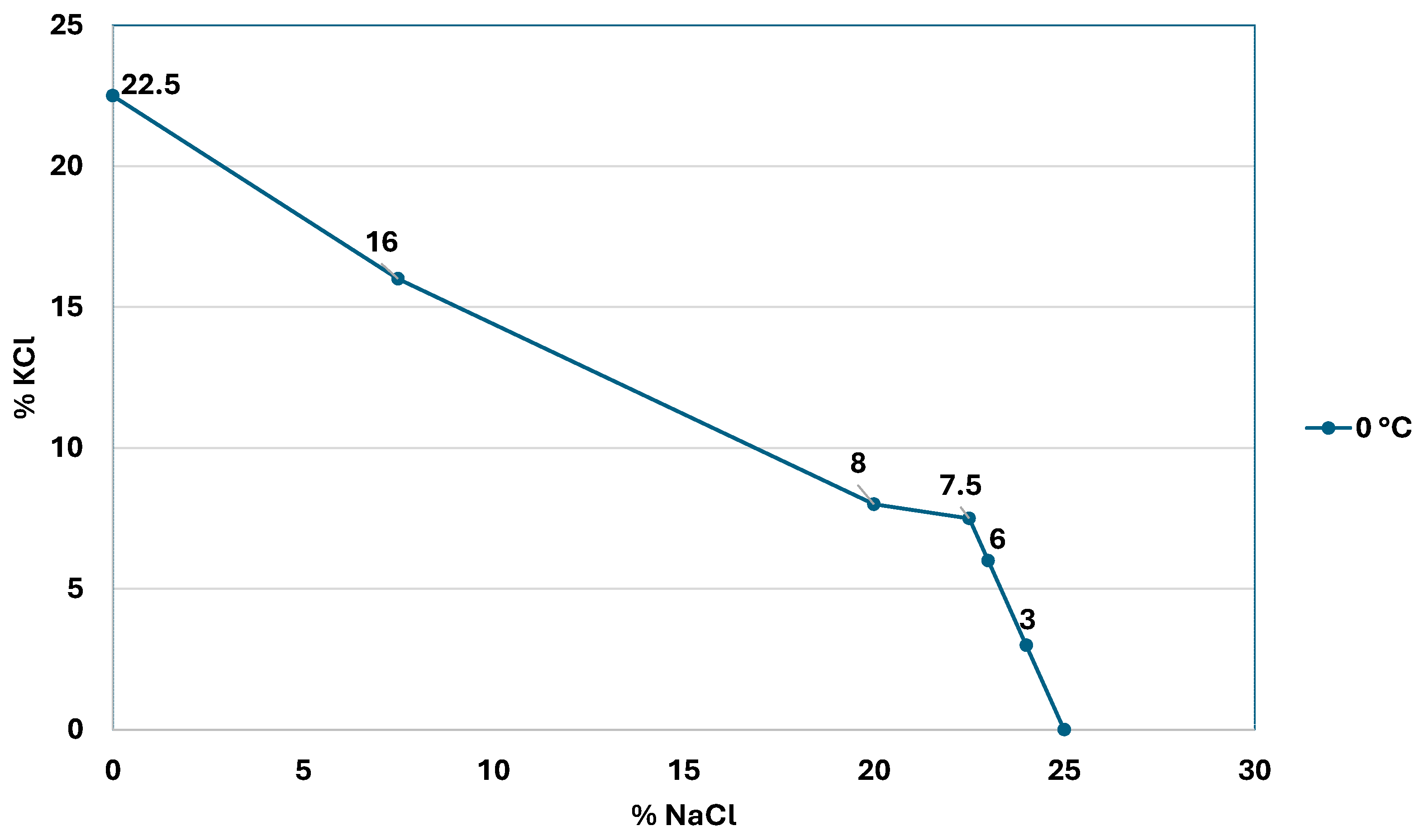
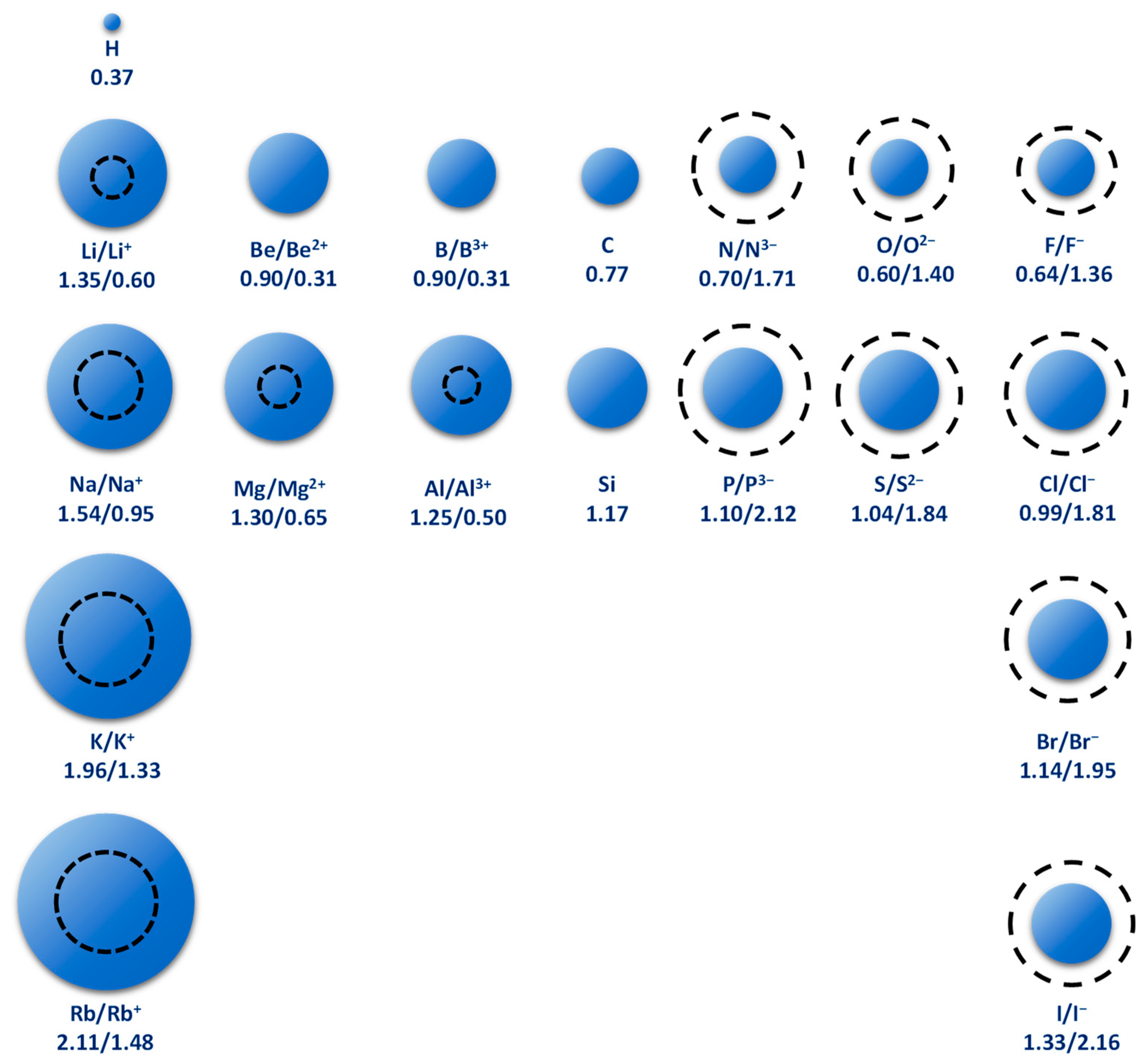


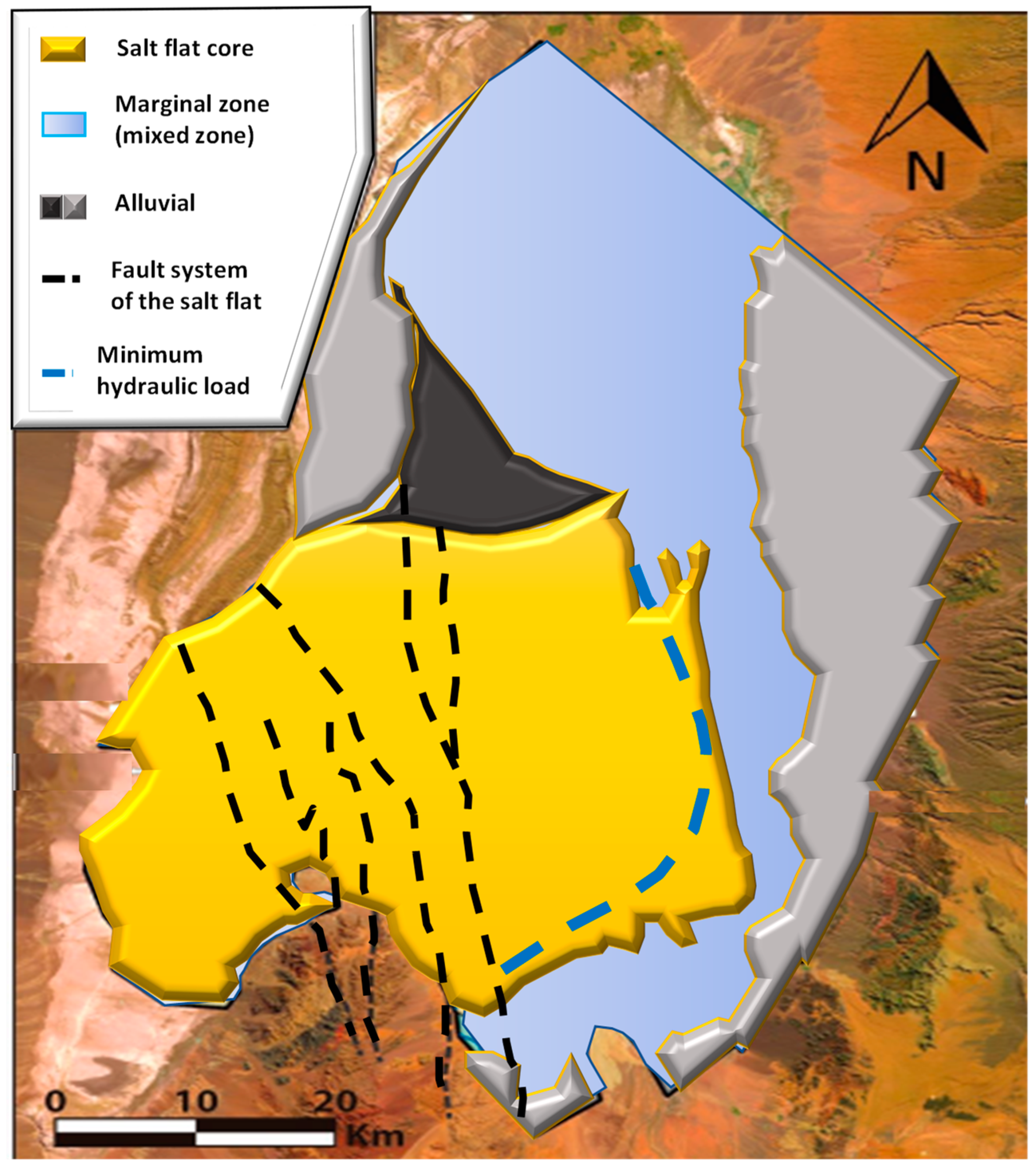
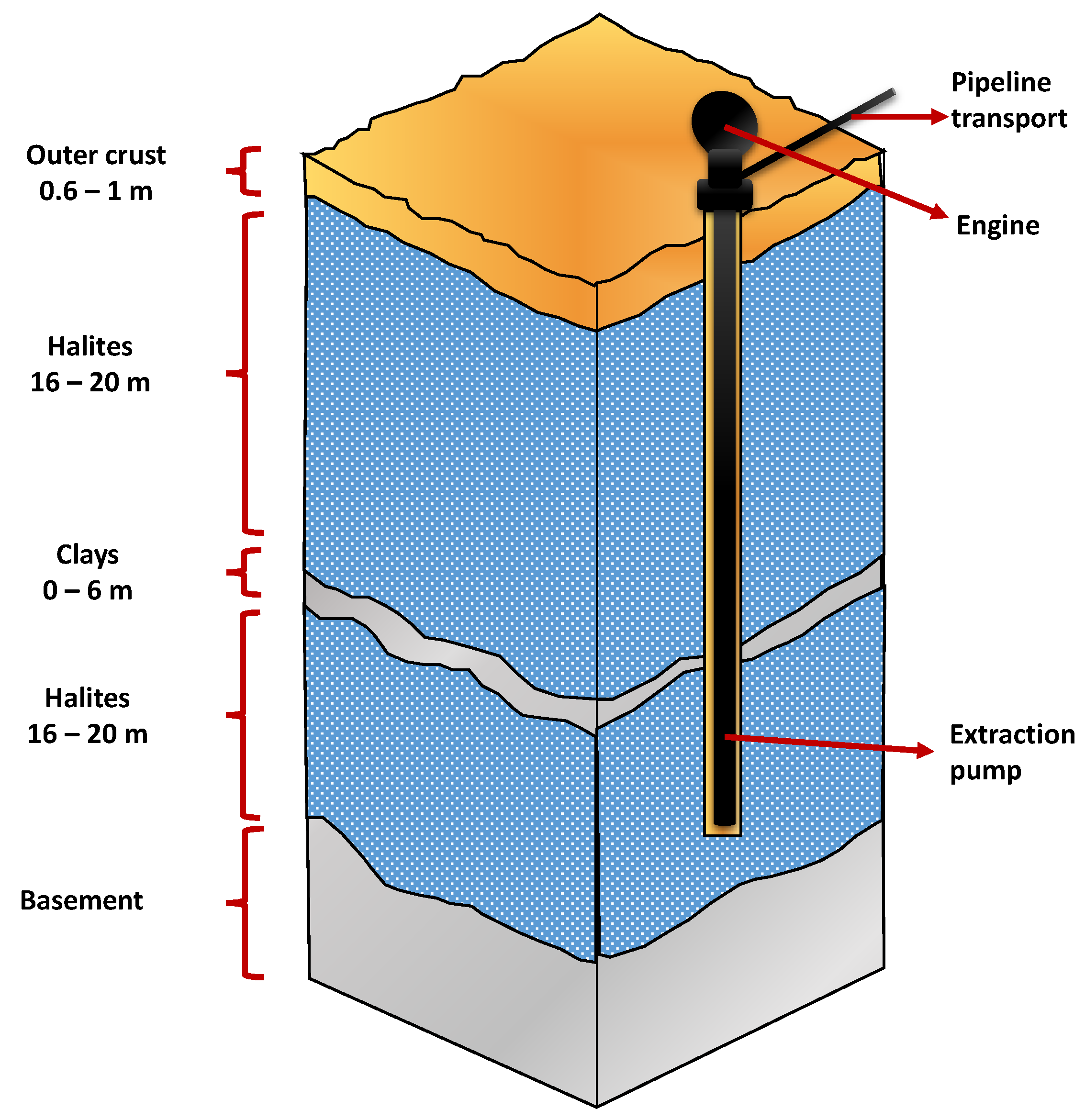
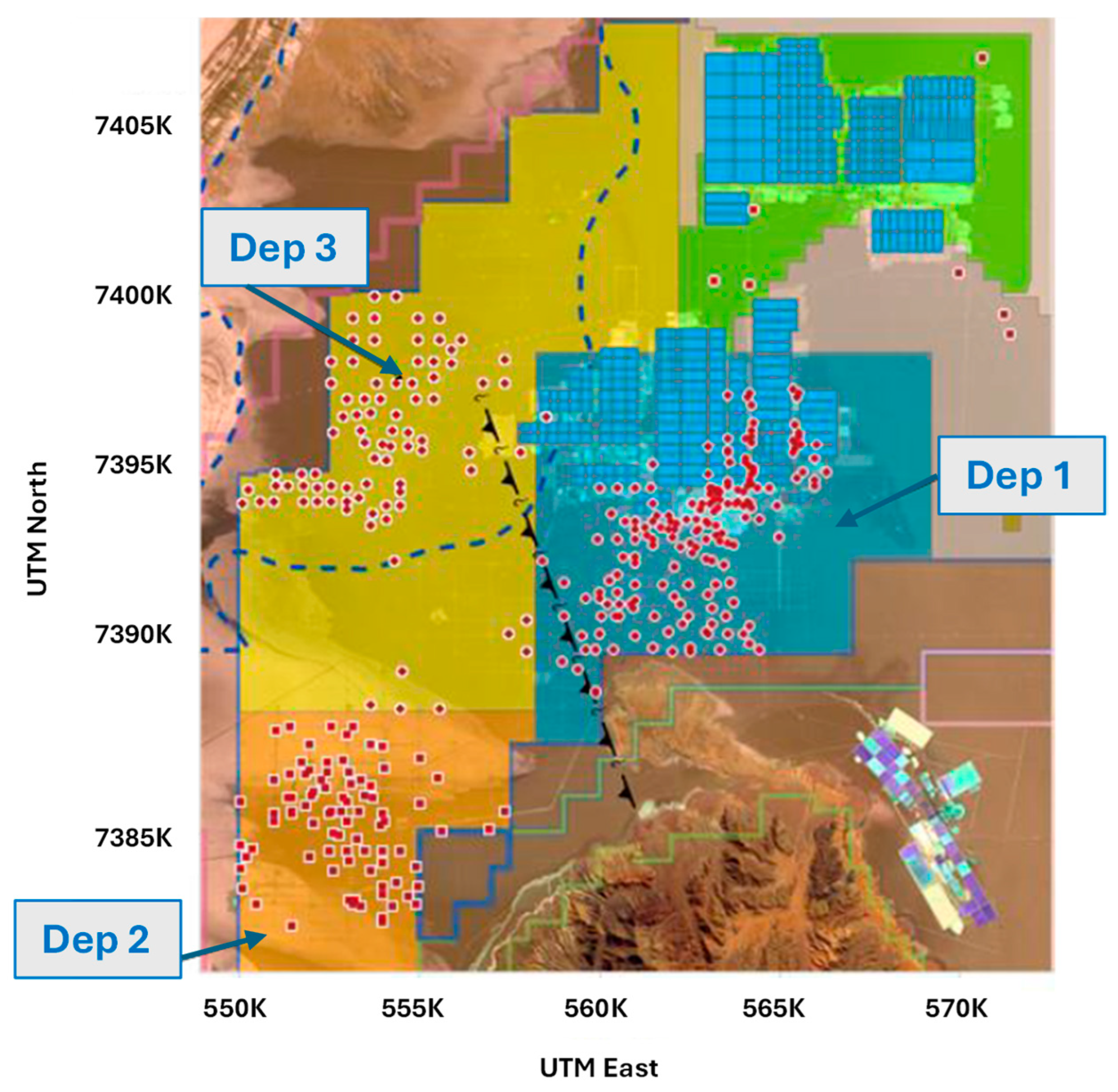
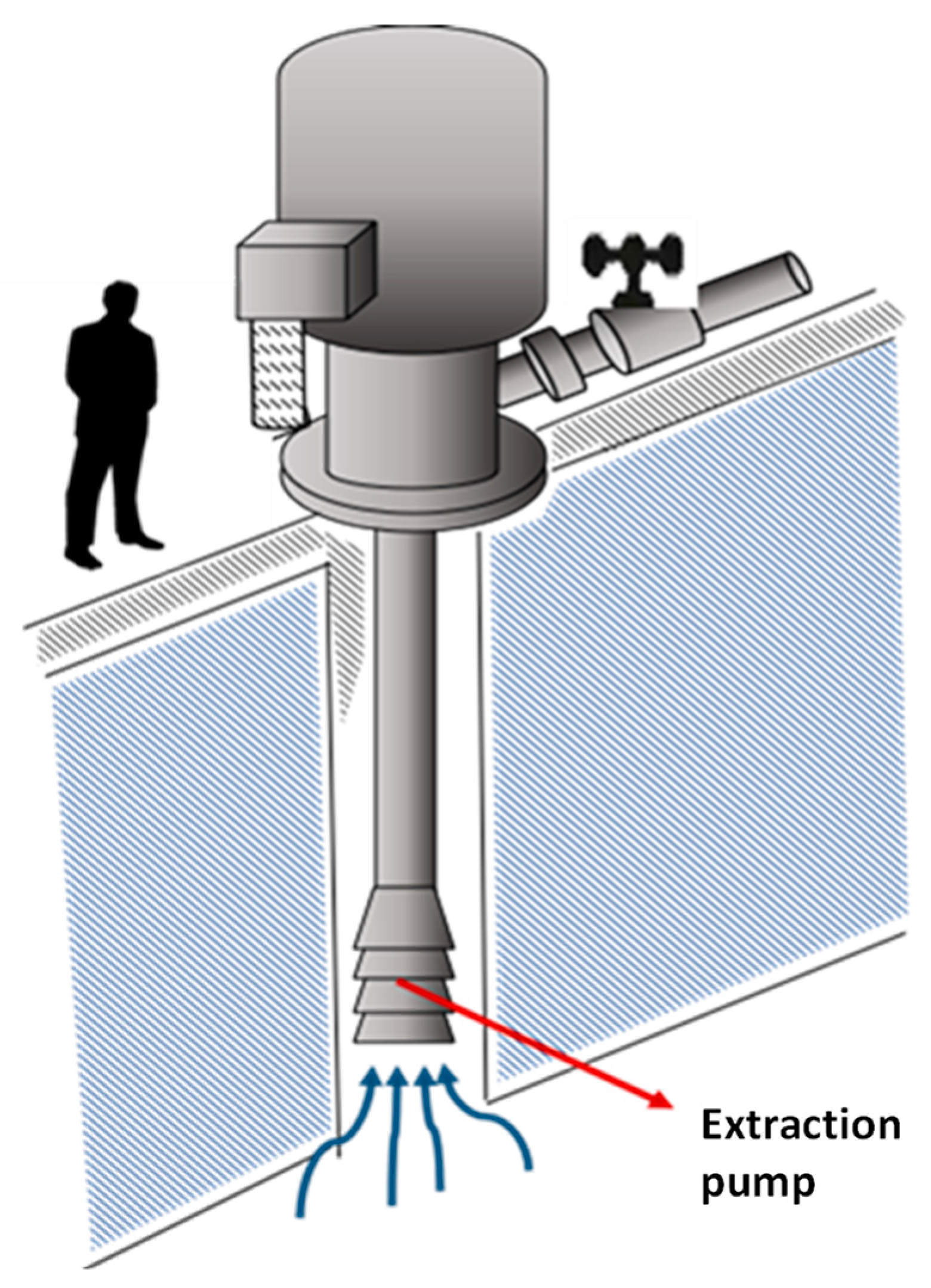
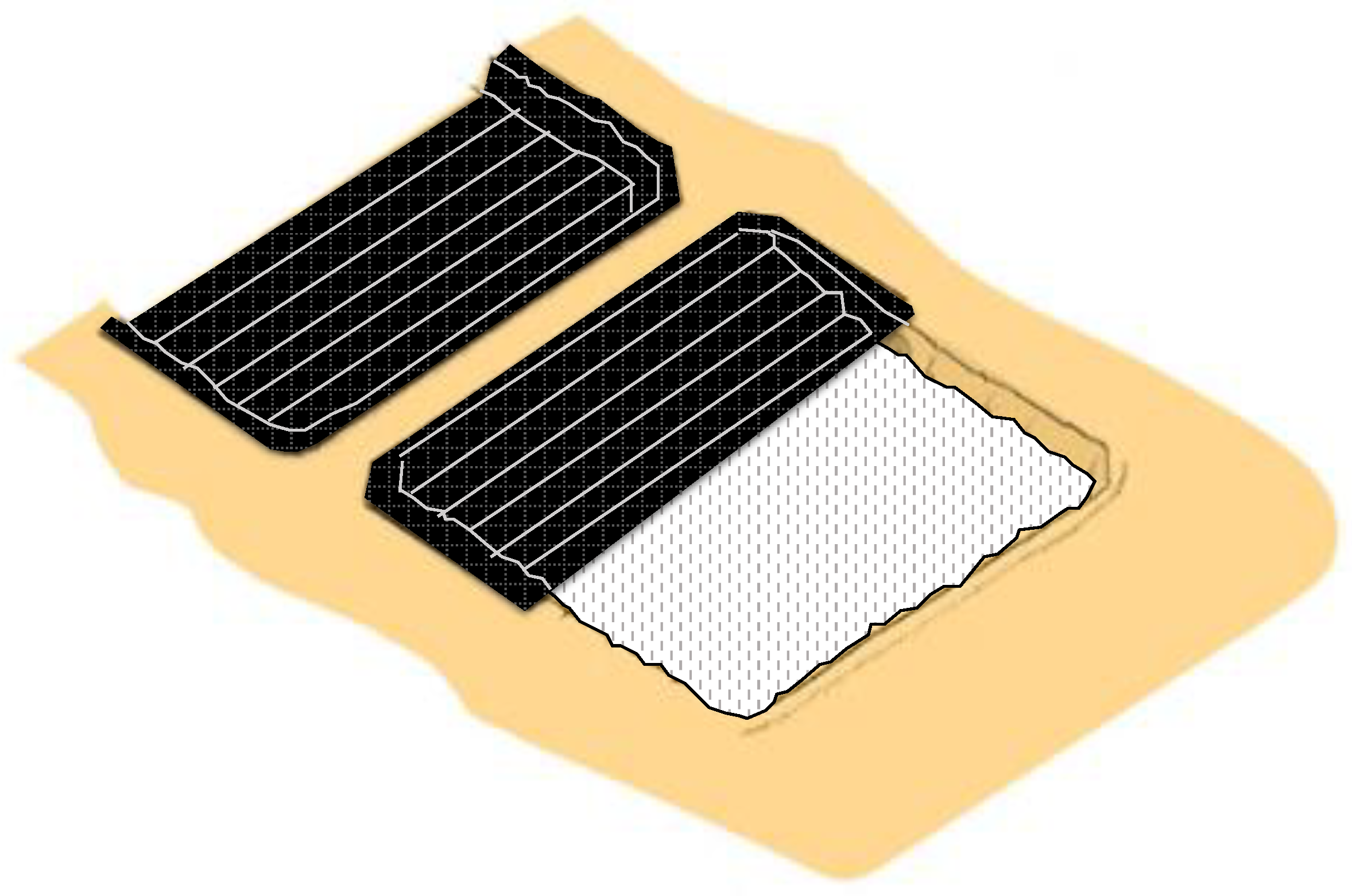
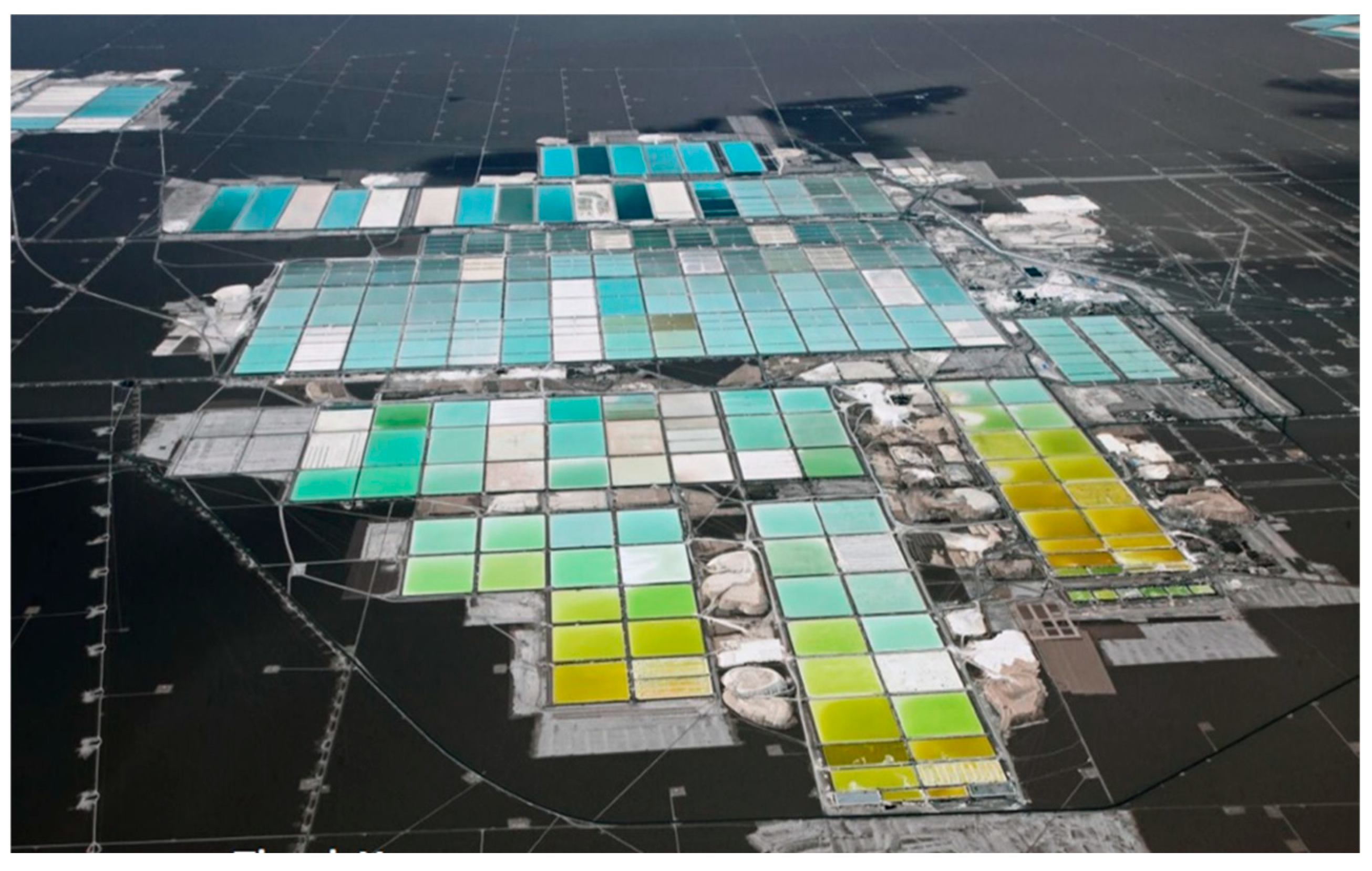

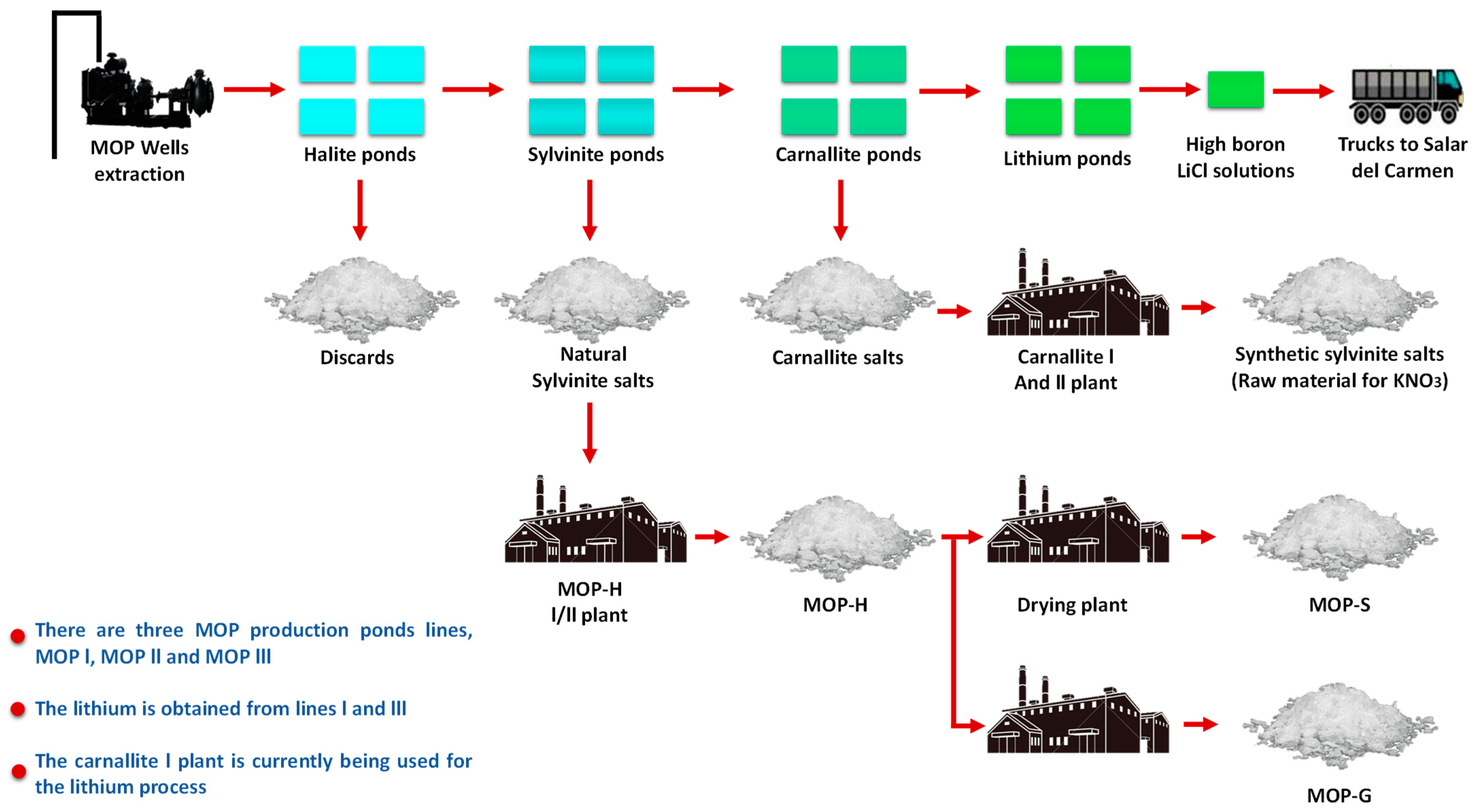

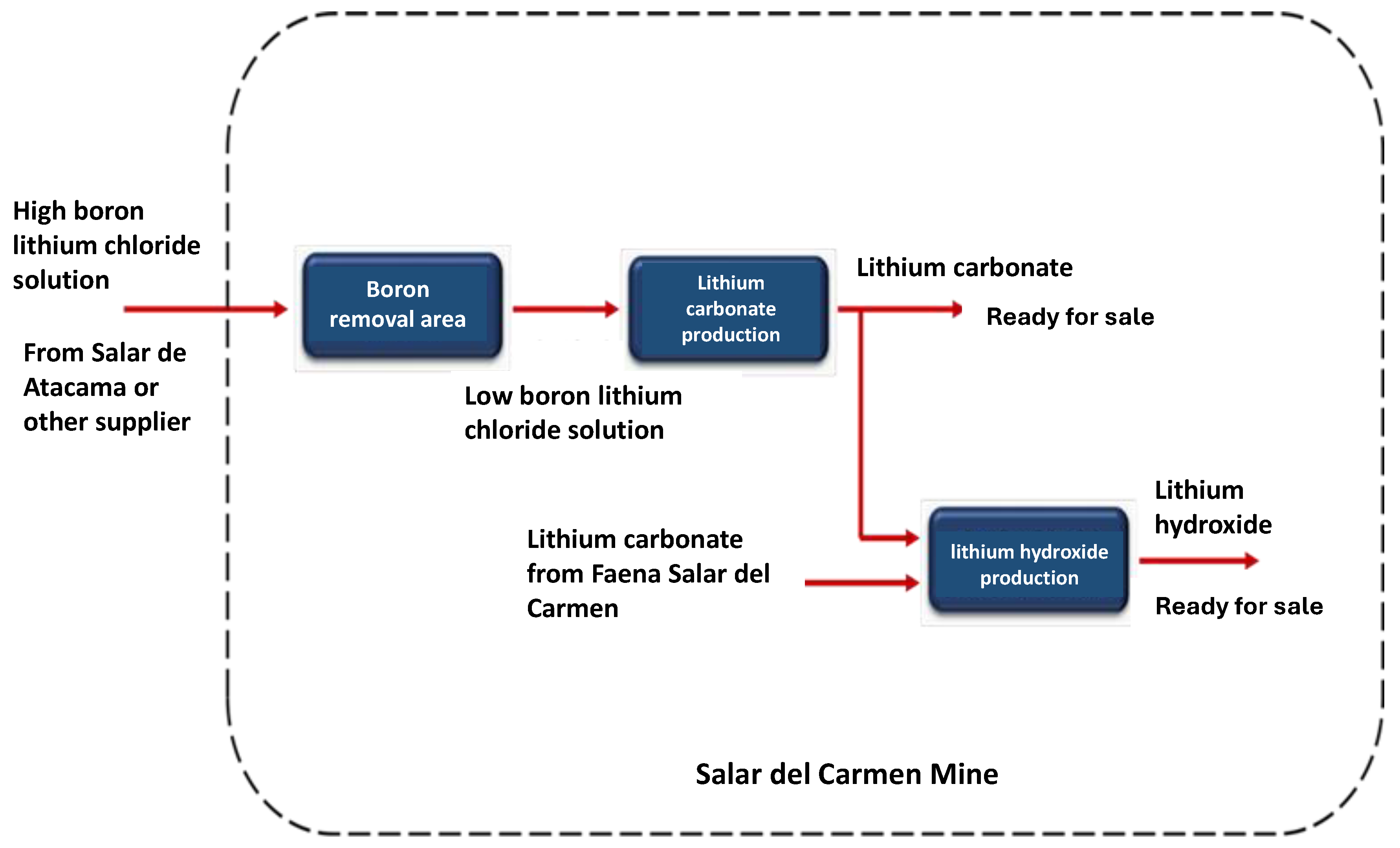
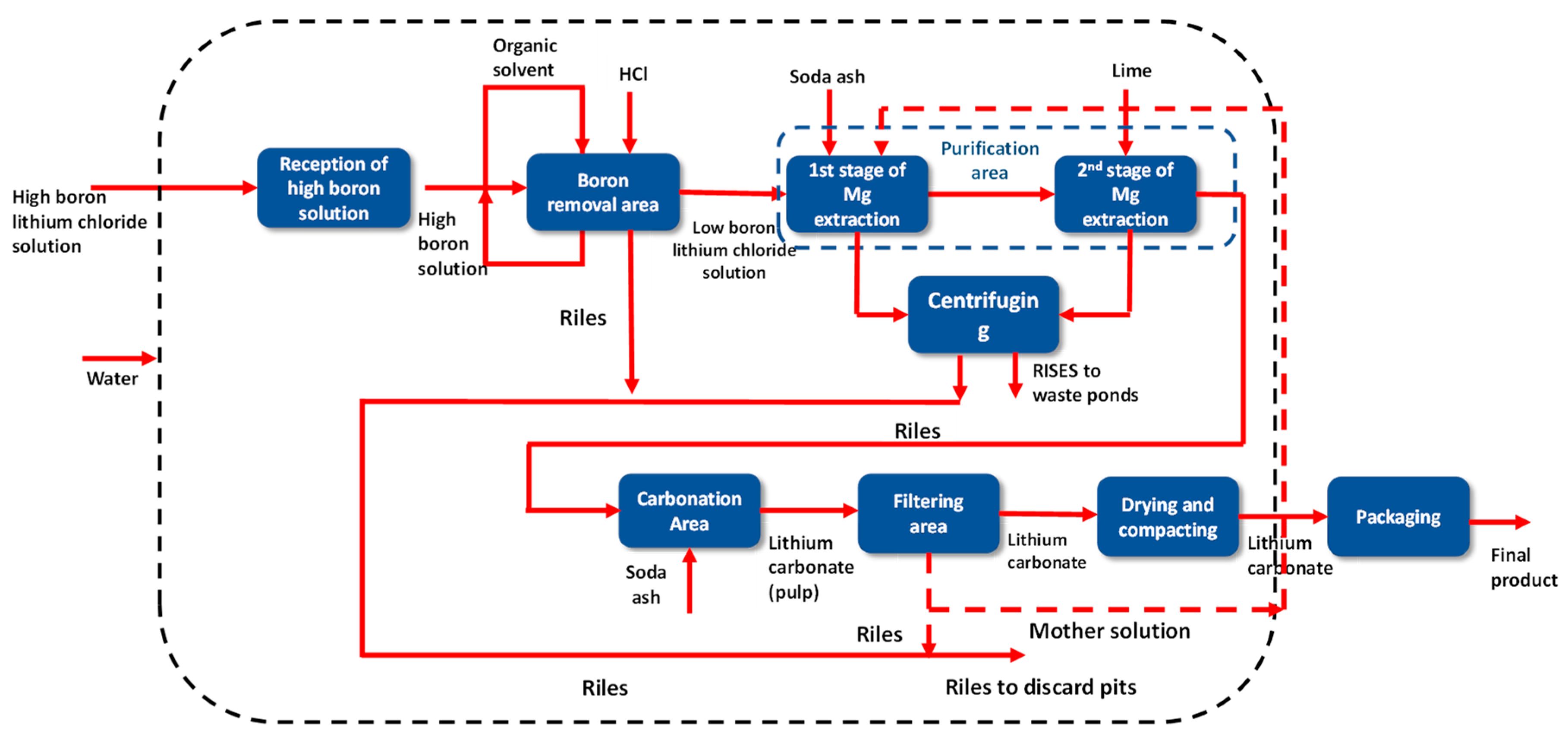
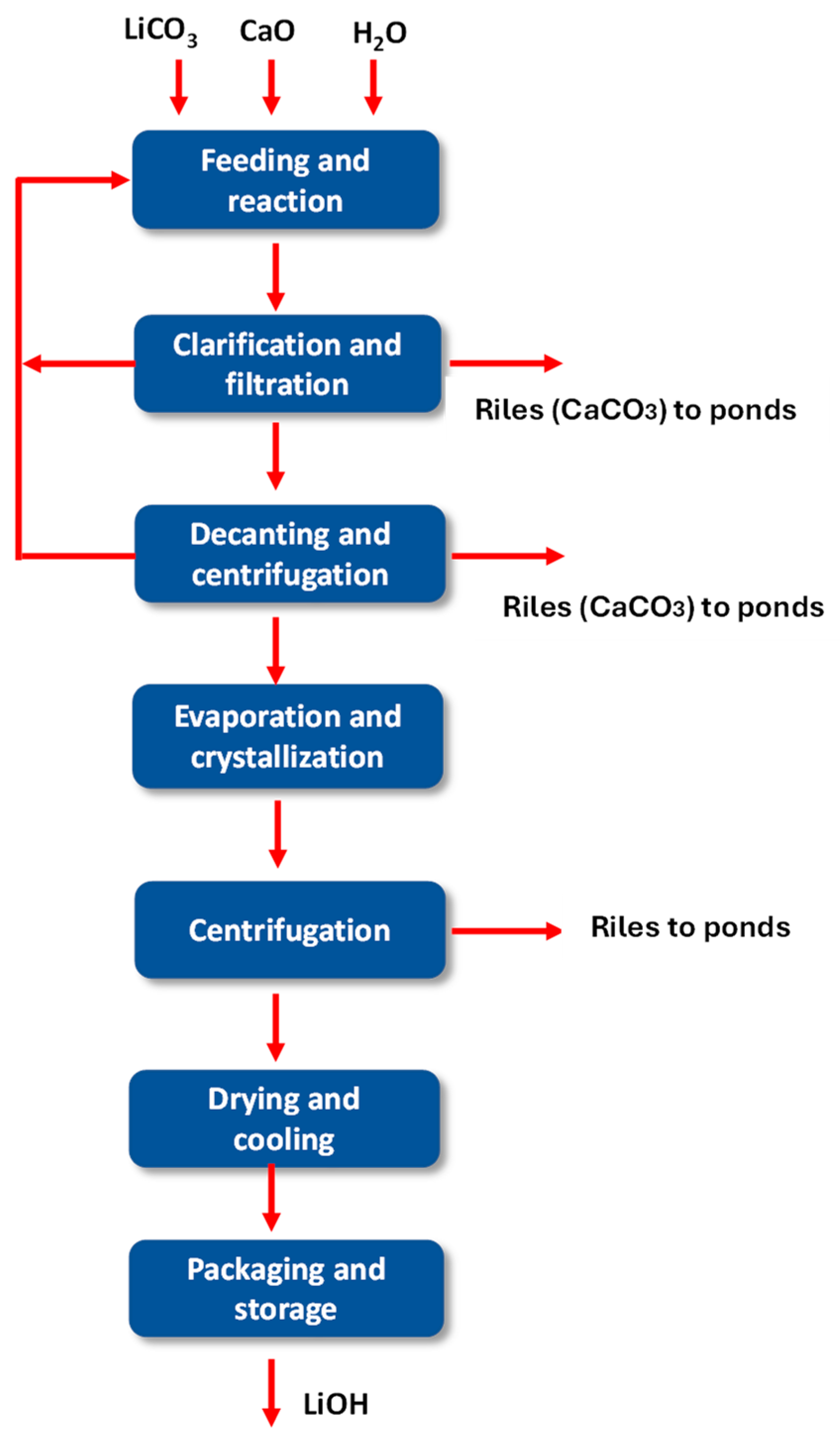
| Compound | Solubility (g/100 gH2O) |
|---|---|
| LiCl | 84.5 |
| CaCl2 | 81.3 |
| MgCl2 | 56.0 |
| KCl | 35.5 |
| NaCl | 36.0 |
| Deposit Characteristics (mg/L) | |||||||||
|---|---|---|---|---|---|---|---|---|---|
| Deposit | Li | K | Mg | Ca | SO4 | B | Mg/Li | SiO4/Li | Ca/Li |
| Salar de Atacama Average | 1835 | 22,626 | 11,741 | 379 | 20,000 | 783 | 6.4 | 10.9 | 0.2 |
| Salinas Grandes Salt Flats | 775 | 9289 | 2117 | 1450 | 1036 | 232 | 2.7 | 1.3 | 1.9 |
| Dead Man’s Salt | 744 | 7404 | 1020 | 636 | 10,236 | 420 | 1.4 | 13.8 | 0.9 |
| Salar de Hombre Muerto EastSide | 745 | 8318 | 1781 | 8642 | 2.4 | 11.6 | |||
| Silver Peak | 245 | 5655 | 352 | 213 | 7576 | 85 | 1.4 | 30.9 | 0.9 |
| Salar de Olaroz (production Wells) | 774 | 6227 | 2005 | 416 | 18,630 | 1136 | 2.6 | 24.1 | 0.5 |
| Cauchari Salt Flat | 618 | 5127 | 1770 | 476 | 19,110 | 1360 | 2.9 | 30.9 | 0.8 |
| Salar de Uyuni Average | 424 | 8719 | 7872 | 557 | 10,342 | 2442 | 18.6 | 24.4 | 1.3 |
| Rincon Salt Flats | 397 | 7513 | 3419 | 494 | 12,209 | 331 | 8.6 | 30.7 | 1.2 |
| Maricunga Salt Flat | 1036 | 8869 | 8247 | 11,919 | 1095 | 634 | 8.0 | 1.1 | 11.5 |
| Compound | Solubility [g/100 g H2O) |
|---|---|
| LiOH | 12.5 |
| NaOH | 100 |
| KOH | 120.8 |
| Mg(OH)2 | 0.00069 |
| Compound | Solubility [g/100 g H2O) |
|---|---|
| Li2CO3 | 1.3 |
| NaCO3 | 30.7 |
| K2CO3 | 111.4 |
| MgCO3 | 0.18 |
| CaCO3 | 0.00066 |
| Height (m) | 2300 |
| Basin Surface (km2) | 18,100 |
| Salar surface (km2) | 3000 |
| Surface of the lagoon (km2) | 12.6 |
| Salar Precipitation (mm/year) | 25 |
| Mountain Range Precipitation (mm/year) | 300 |
| Salar potential evaporation (mm/year) | 2000 |
| Mountain range potential evaporation (mm/year) | 1600 |
| Basin | Region | Li Min (mg/L) | Li Max (mg/L) | Mean Li (mg/L) | Li (Mt) Resources |
|---|---|---|---|---|---|
| Atacama Salt Flats | Chile | 900 | 7000 | 1800 | 6.3 |
| Maricunga Salt Flat | Chile | NA | NA | 920 | 0.22 |
| Surire Salt Flat | Chile | NA | NA | 340 | 8.3 |
| Salar del Hombre Muerto | Argentina | 190 | 900 | 521 | 0.8 |
| Salar del Rincon | Argentina | Ma | Na | 400 | 0.223 |
| Salar de Olaroz and Salar de Cauchari | Argentina | 282 (200 Olaroz) (250 Cauchari) | 1207 (2150 Olaroz) (650 Cauchari) | 650 (510 Olaroz) (450 Cauchari) | 0.9–1 |
| Llullaillaco Salt Flats (Mariana) | Argentina | 250 | 650 | 450 | NA |
| Uyuni Salt Flat | Bolivia | 80 | 1150 | 321 | 10.2 |
| Salar de Capaisa | Bolivia | NA | NA | 243 | NA |
| Salar de Pastos Grandes | Bolivia | 353 | 1787 | 1062 | NA |
| Clayton Valley | Nevada | 100 | 300 | 160 | 0.3 |
| Searles lake | California | 10 | 80 | 65 | NA |
| Salton Sea | California and Mexico | 100 | 400 | 200 | 0.316 |
| Great Salt Lake | Utah | 18 (north) 40 (south) | 43 (north) 64 (south) | 52 | 0.53 |
| Dead Sea | Israel | NA | NA | 10 | NA |
| Tilanier (Tainer) Lake | Qaidam, China | NA | NA | 290 | 2.02 |
| Dangxtongeno | Tibet, China | NA | NA | 430 | 0.181 |
| Li | Mg | Na | K | Ca | SO4 | B | Cl |
|---|---|---|---|---|---|---|---|
| 6.00% | 1.40% | 0.08% | 0.02% | 0.033% | 0.019% | 0.80% | 35% |
Disclaimer/Publisher’s Note: The statements, opinions and data contained in all publications are solely those of the individual author(s) and contributor(s) and not of MDPI and/or the editor(s). MDPI and/or the editor(s) disclaim responsibility for any injury to people or property resulting from any ideas, methods, instructions or products referred to in the content. |
© 2024 by the authors. Licensee MDPI, Basel, Switzerland. This article is an open access article distributed under the terms and conditions of the Creative Commons Attribution (CC BY) license (https://creativecommons.org/licenses/by/4.0/).
Share and Cite
Torres, D.; Pérez, K.; Galleguillos Madrid, F.M.; Leiva, W.H.; Gálvez, E.; Salinas-Rodríguez, E.; Gallegos, S.; Jamett, I.; Castillo, J.; Saldana, M.; et al. Salar de Atacama Lithium and Potassium Productive Process. Metals 2024, 14, 1095. https://doi.org/10.3390/met14101095
Torres D, Pérez K, Galleguillos Madrid FM, Leiva WH, Gálvez E, Salinas-Rodríguez E, Gallegos S, Jamett I, Castillo J, Saldana M, et al. Salar de Atacama Lithium and Potassium Productive Process. Metals. 2024; 14(10):1095. https://doi.org/10.3390/met14101095
Chicago/Turabian StyleTorres, David, Kevin Pérez, Felipe M. Galleguillos Madrid, Williams H. Leiva, Edelmira Gálvez, Eleazar Salinas-Rodríguez, Sandra Gallegos, Ingrid Jamett, Jonathan Castillo, Manuel Saldana, and et al. 2024. "Salar de Atacama Lithium and Potassium Productive Process" Metals 14, no. 10: 1095. https://doi.org/10.3390/met14101095
APA StyleTorres, D., Pérez, K., Galleguillos Madrid, F. M., Leiva, W. H., Gálvez, E., Salinas-Rodríguez, E., Gallegos, S., Jamett, I., Castillo, J., Saldana, M., & Toro, N. (2024). Salar de Atacama Lithium and Potassium Productive Process. Metals, 14(10), 1095. https://doi.org/10.3390/met14101095










